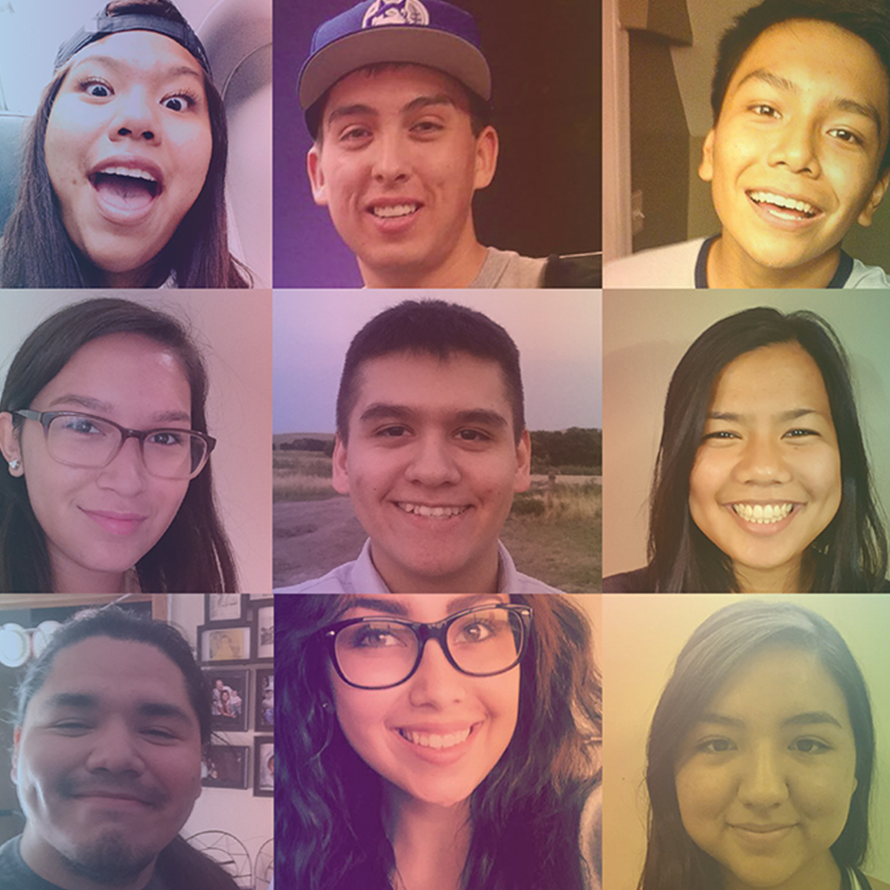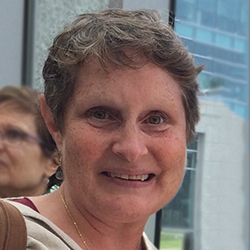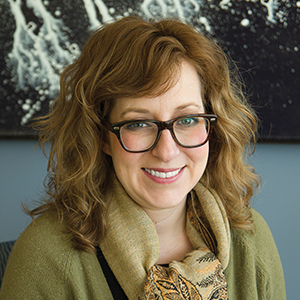‘I wanted to be here, and I like it here’
About a dozen interns gathered in the sunny atrium of Building 35 on the National Institutes of Health campus in Bethesda on a blistering day in July. They were sweaty and fanning themselves after trekking under what meteorologists had dubbed a “heat dome.”
They’d spent the afternoon at the Indian Health Service, which is a federal health care provider. The interns had traveled there and back on the D.C. metro, which sometimes does and sometimes does not have air conditioning.
 The collage shows some of the Native American students who interned at the NIH this summer. Top (left to right): Courtney John, Skyler Bordeaux and Cole Dittentholer. Middle: JoAnne Compo, James Chief and Claire Marie Perez. Bottom: Henry Herman, Myriam Alcantar-Rama and Marilyn Franks.
The collage shows some of the Native American students who interned at the NIH this summer. Top (left to right): Courtney John, Skyler Bordeaux and Cole Dittentholer. Middle: JoAnne Compo, James Chief and Claire Marie Perez. Bottom: Henry Herman, Myriam Alcantar-Rama and Marilyn Franks.
Some of the interns were old hands at the region’s public transportation system, having spent a few summers already at the NIH. Others were new, still learning the ropes and delighted by the subway.
All were obedient, though not necessarily eager, when Rita Devine corralled them into a small, windowed conference room overlooking the well-lighted atrium to talk.
As they rummaged through their backpacks and checked their cell phones, they grumbled a bit about practically needing an escort to breathe while at the IHS.
“Well, you guys didn’t embarrass the family name or anything?” Devine asked jokingly.
“I did!” a young man joked back.

Devine, the assistant director for science administration at the National Institute of Neurological Disorders and Stroke and one of the NIH’s internship coordinators, is used to the students’ good-natured ribbing.
She has raised two children of her own, and she sounded much like a parent as she tried to squeeze information out of the interns about their visit: “So, you met Damian? He talked to you about the scholarships? Anything about scholarships for master’s programs?”
Devine has overseen the participation of Native Americans in the NIH summer internship program for the past nine years. In 2007, she recalled, her boss told her, “There are no Natives in this program. You need to do something about that. See if you can fix it.”
So she did just that.
This summer, Native American students made up 15 percent of the summer cohort of interns at NINDS. That’s impressive given that Native Americans make up only about 1.5 percent of the U.S. population and are underrepresented in science, technology, and engineering and math careers.
Former NIH interns are beginning to make inroads in their respective fields. “Right now, we’ve got three of our youngsters in medical school,” Devine said. “One’s going to be starting this fall. And another one, who’s what we call an urban Native, who did not grow up in a reservation, is a neurosurgeon looking for a residency.”
Happy happenstance
Devine didn’t start out with a career in science training in mind. She earned her undergraduate degree in animal science from the University of Delaware in 1983. When she graduated, she needed to pay off her school loans, so she got a job as a technician in a tropical medicine lab. After that, she went to graduate school at Georgetown University, earning her Ph.D. in developmental biology in 1993. She followed that up with two postdoctoral fellowships at the NIH.
“I was going to actually start a business of my own doing microscopy, because I love to do electron microscopy,” she told me. A few weeks before she finished up her second postdoctoral fellowship, Story Landis, who was the scientific director at NINDS, offered Devine a permanent job at the NIH doing part-time research and part-time administrative work.
In that position, when she wasn’t at the bench, Devine was translating researchers’ lab space requirements for architects and contractors.
“(Landis) needed somebody who knew the science and could talk to the (principal investigators) and who the PIs would trust as an administrator,” she said.
Soon enough, Devine got involved in long-range strategic space planning, looking at where the science was going and making sure the NIH campus would be physically ready for new recruits and pursuits.
“But, like with most split jobs, you’re doing two full-time jobs. I just couldn’t do it,” she said. She gave up the bench.
At that time, she reported to Henry McFarland, an Arizona native who led the NINDS neuroimmunology branch. When he asked her to start recruiting Native American students to the summer program, Devine wasn’t sure she had the bandwidth for it. “I thought I already had too much to do,” she said. But she accepted the assignment anyway with the idea that it wouldn’t be too big of a deal.
Boy, was she wrong.
It starts with recruiting
Several times a year, Devine heads out to visit tribal elders at their reservations, school administrators and community groups. This summer she went to New Mexico.
She has made many connections over the years; information about the program often spreads by word of mouth. Several of the interns in the cohort this year are from the same reservation.
But it hasn’t always been this way. Devine has worked hard to earn parents’ and community leaders’ trust. “For the first couple of years, I sold my soul several times, saying, ‘I’ll make sure to take care of your kid.’ That seemed to work,” she said.
Imagining the potential cultural minefield, I asked her how she prepared for her visits and, in particular, if she’d read any books.
“I haven’t read that book, but I probably could write that book,” she quipped.
Indeed, missteps were inevitable. Once, she tried to persuade a tribe in Maine to meet with her, but they refused her invitation.
“I couldn’t understand it. I’d gone all the way up to Maine to try to visit with them, and they wouldn’t see me,” she recalled. “Of course, I hadn’t done appropriate homework. What had happened was, in the ’50s, their kids were taken from this island they lived on and were forced to assimilate in Boston. And I’m thinking, well, here I am, some white person (saying), ‘Give me your kids.’ Yeah, they didn’t want to talk to me.”
For more than a century, the federal Bureau of Indian Affairs and religious groups orchestrated the removal of Native American children from their homes and placed them in non-Native households and boarding schools so that they would assimilate. The Indian Child Welfare Act of 1978 aimed to end this practice and gave tribes jurisdiction over custody cases, but tensions remain to this day in light of the disproportionate rate at which Native children are placed by the state into the foster care system.
In 2013, Maine officials and tribal leaders created the nation’s first Truth and Reconciliation Commission, modeled after those in Africa and South America. Last year, the commission found that Native American children are five times more likely to be placed in foster care than non-Native children.
Even after learning about the past abuses and appealing to the tribe elders, Devine couldn’t persuade them to allow their children to participate in the government-sponsored internship program. “They wouldn’t see me. But I have overcome that with other tribes now because I learned from that,” she said.
Like nothing they’ve ever known
The minimum age to participate in the summer program is 16. Devine acknowledges that that’s pretty young but says that’s intentional. She jokes that “around here you get a résumé around age 5,” and there’s a hint of truth in that.
Montgomery County, which houses the sprawling NIH campus and many other federal offices, is one of the wealthiest counties in the nation. The median household income is more than $94,000. The NIH itself is nestled among multimillion-dollar homes.
Compare that with the Pine Ridge Indian Reservation in South Dakota, home to several of the interns, where almost half of residents live below the federal poverty line.
“You know, it’s a tough go. The reservations are a tough place to grow up often. So we do a lot of things. We recruit them. We walk them through the process,” Devine said. “The goal is to get them through high school and help get them into college — and make sure they know they have support.”
The students start arriving in Bethesda in late May, and they can stay through the end of September if they want.
“They’re supposed to spend at least eight weeks in the program. Sometimes, if it’s literally the first time off reservation, they can’t stay that long because they get too homesick,” Devine said.
During their stay, they live with volunteer host families. Devine is responsible, though unofficially, for making those arrangements too.
“Initially, all the kids came to our house first, because it was a trust deal. They needed to know where they were going, and their parents needed to know where they were going,” she said. “They came here, and we’d get them settled. Make sure everyone was comfortable. And then the host families would come pick them up at our house or we’d take them there.”
These days, for the most part, they stay at the homes of their host families from the start. That is, if host families can be found. The housing part of the program, Devine says, is “the toughest thing to sustain.” The NIH has no official role in securing housing for interns. But Devine handles it anyway.
Some host families keep the students the entire summer. Others can offer only a few weeks.
“We’ve been very — knock on wood — very, very fortunate. There’s a lot of good people in this area,” she said. “The agreement I did make with the tribal leaders when I started this was that they would not be put in apartments, hotels or dorms, because they were so afraid of the alcohol and drug issues that they wanted them put in a family setting.”
Devine advertises the need for host families at religious centers, houses of worship and community message boards — using her personal email address to comply with NIH regulations. When too few families step up, she has been known to enlist her own family members. And, she says, “any given day in the summer, you might find a bunch of kids sprawled on my floor if their housing doesn’t work out.”
Once the interns are settled, they begin their NIH assignments in basic research laboratories and clinical settings.
Student experiences
Harvey Herman is a senior at Creighton University in Omaha. He’s from Mission, South Dakota, the largest city in the Rosebud Indian Reservation, home to a branch of the Lakota people. This was Herman’s second summer at the NIH.
For a while, Herman thought he’d like to become a physician. Last year he worked with the herpes virus at the NIH. This summer he studied exosomes.
But he was impressed this summer by the work of a guest speaker who studies neuroplasticity and works with indigenous populations. Herman said hearing about her work made him reconsider his plans.
“She and I talked one-on-one a little bit, and she helped lessen the effects of depression in some of her (patients) just by doing mind-training games that help work different parts of the brain,” he said. “I thought that was pretty fascinating, because I struggle with depression, and this year it kind of killed me — like killed me a lot. And what I want to do is get a Ph.D. in psychology with an emphasis on addiction studies. I want to work back on the reservation with that, because there are a lot of addiction issues.”
Myriam Alcantar–Rama is from Pine Ridge Indian Reservation. She’s a sophomore on the premed track at the University of New Mexico.
This was Alcantar–Rama’s third summer at the NIH. At the National Human Genome Research Institute, she’s studying drug resistance in melanoma and in the lab performs Western blots on the gene products of SOX10 and PTEN.
Though she’d like to be a pediatrician one day, for now she’s double majoring in biology and linguistics.
“My dad is fluent in Lakota, and so in my house he only speaks Lakota. So I know a lot of Lakota, and I know a lot of Spanish as well. I’m really good at picking up languages,” she said.
This was the second summer at the NIH for James “Jamie” Chief, also of the Pine Ridge Indian Reservation.
Chief, a premed student at Montana State University, is helping to map GABAergic neurons in respiratory regions in adult transgenic rats in Jeffrey Smith’s lab at the NINDS. “We inject these viral vectors in them, and we let them do their thing. Then we extract the brains. We do slices first, and then we stain them.”
While some interns return to the same labs year after year, others, including Chief, try out new ones, which has its benefits.
“The lab I was in last year … it was pretty much just me and (the PI) in the lab, working on whatever it is we were working on that day,” Chief said. “But in the lab I’m in now, it’s three interns, one postbacc and like three postdocs — all in one big lab, everyone rushing around like crazy ants. It’s a lot more chaotic. But it’s good having the extra interaction, asking what everybody is doing, seeing what they’re working on.”
For first-time interns like Joanne Compo of the Yakama Indian Reservation in the state of Washington, just the idea of traveling across the country sounded a little crazy initially.
“It was weird coming here, kind of out on a limb,” said Compo, who is beginning her studies at the University of Washington this fall. “It’s cool to come out here and have this experience, because I would get nothing like this even miles away from home.”
Compo noted that many of the interns were strongly encouraged by their parents to participate.
“I think I have a different situation than a lot of people here, because my parents didn’t go to college,” Compo said. “It wasn’t that they weren’t pushing me, but if I wasn’t going to go to college or do any after-high school education, it wasn’t that big of a deal. They kind of left it up to me, but I decided that I wanted to be here and I like it here.”
Cherella Hughes, a senior public health major at Fort Lewis College in Durango, Colorado, also is from the Pine Ridge Indian Reservation. Both of her parents hold master’s degrees.
Hughes is working in a clinical setting at the NIH and analyzes interviews with patients who are depressed and who have suicidal ideation.
“Our main focus is the 48 hours before their (suicide) attempt, but mostly want to know what happened in the 24 hours leading up to their attempt. So, like, did they have a stressful life? Did they have work issues, family issues? Did they consume alcohol or any other substances?” she said.
Hughes said she has lost a number of friends and family members to suicide. Other interns said the same.
“Every week, you know, somebody committed suicide. I was able to deal with it in my own ways. I feel very sorry for the family and anyone close to them. But at the same time, my stepfather works with suicide prevention every day. He’s on call a majority of the time. So it kind of became normal for me,” Hughes said. “I think that, in the end, as long as you’re able to help someone in some way, then even though it’s a stressful issue, I just feel like people come here to NIH because they realize they suffer from depression and they want to help others as well.”
Hughes said she looks at the experience as a way one day to help those in her community, in particular youth who suffer from depression. Though suicide rates vary by tribe, the data make one thing perfectly clear: No other U.S. population loses young adults to suicide at the rate at which Native Americans do.
Though Hughes has spent four summers at the NIH, she’s considering doing a two-year postbaccalaureate stint there after she graduates. Like a lot of the other interns, she’s ready to get a jump on her career and isn’t interested in wasting any time.
“I’m not trying to sound mean or stereotype,” she said, “but I always like joke around whenever I hear that (new grads are taking time off to travel). Because we come from very low-income families, and that is such a non-Native thing to do. It’s like ‘I’m going to go find myself.’ But I already know who I am,” she said. “I think it would be great to travel for vacation …”
Devine piped up: “Cherella, what’s that saying?”
Hughes paused and then continued: “‘Remember who you are and what you stand for.’ I think it also goes back to, like, because I grew up very traditionally Lakota, I kind of feel like I always knew where I belonged.”
Extracurricular activities
Each summer, Devine schedules a number of field trips so that the interns can get the most out of the regional offerings.
They visit the Smithsonian’s National Museum of the American Indian, “which they hate,” she noted. They attend an American Indian Science and Engineering Society chapter meeting. They go to events on the National Mall. They present posters at scientific meetings.
Devine, with help from members of the Native scholars group at the NIH, arranges an annual tubing trip on the Potomac or Shenandoah rivers, and she and her husband invite the interns to spend time at their vacation home. “We have a weekend house on the river. So their host families can get a break, they come with us down there,” she said.
Before summer comes to a close, Devine added, “we have a big barbecue here at our house, and all the kids are required to come.” Representatives from the Society for Advancement of Chicanos/Hispanics and Native Americans in Science and AISES join them at the cookout.
Live and learn
Katherine Roche is a senior investigator at the NINDS. Her research program focuses on how synaptic proteins are trafficked to and retained at synapses. She’s also the training director at the NINDS and this summer hosted interns in her lab for the first time.
“It’s good to have senior people that know their way around, but it’s also fun to have students, either graduate students or undergraduate students — or even high school students — because they always look at things from a fresh perspective and ask naïve questions, which a lot of times aren’t so naïve,” she said. Those questions make “you think more carefully about what you’re already doing.”
Importantly, she said, “A lot of times, students’ ideas about what being a researcher are quite different from the reality.” She said she hopes to instill a love of science in the interns and that she appreciates how having a diverse workforce can make science better.
“(Devine) has become so successful with the Native American outreach that it has become a very vibrant part of our training program — really, all thanks to her hard work and dedication,” Roche said.
Though Devine doesn’t gush about the results she has achieved, she has every right to. She said she appreciates that the interns and their families trust her and are willing to teach her about their cultures. “I find that if you’re open to folks and just ask questions and make sure that they know that you want to understand and appreciate, they cut you a little bit of slack,” she said.
She has learned a lot over the years, and she laughs off some of the more comical misunderstandings, like the time the Navajo interns refused to go up to the third floor of her home, where her son’s room is, to play videogames because there was a mounted deer head on that floor.
“The traditional Navajo have this thing against deer. They fear they cause mental illness,” she said. “The thinking is that maybe out West with wasting disease, maybe eating deer may cause mental illness.”
Devine says she knows some people might think that’s a silly superstition, but she thinks about how her Catholic upbringing influences her own thinking: “I believe some guy died and three days later was resurrected and walking around. It’s where you come from. So I try to really think before I say stuff or assume anything.”
Devine advises mentors and host families to keep an open mind.
When a group of students stayed at her house year after year, she let them burn sage (known as smudging) to purify the place of evil spirits. “I’m OK with that. Have at it! Do what you have to do,” she said.
She also advises that they not underestimate the students. One thing’s for sure, Devine said: “These kids are resourceful. They make my kids look so spoiled … They’re very capable. And they’re cool. They’re cool kids.”
Enjoy reading ASBMB Today?
Become a member to receive the print edition monthly and the digital edition weekly.
Learn moreFeatured jobs
from the ASBMB career center
Get the latest from ASBMB Today
Enter your email address, and we’ll send you a weekly email with recent articles, interviews and more.
Latest in People
People highlights or most popular articles

2024 voter guide
Learn about the candidates running for ASBMB Council, Nominating Committee, Publications Committee and treasurer.

Charles O. Rock (1949 – 2023)
Colleagues and trainees remember a world expert in membrane lipid homeostasis.

Honors for Clemons, Hatzios and Wiemer
Awards, honors, milestones and more. Find out what's happening in the lives of ASBMB members.

Touching the future from the bench
Scholar, scientist, teacher and mentor Odutayo Odunuga discusses the important roles of the institutional PI, his journey and his research.

In memoriam: Darwin Prockop
He held leadership positions at multiple institutions and was known for his contributions to adult stem cell biology and cellular biology.

A look into medical writing
Our careers columnist spoke with Ashlea A. Morgan at Chameleon Communications International to get a sense of one type of work a medical writer can do.

